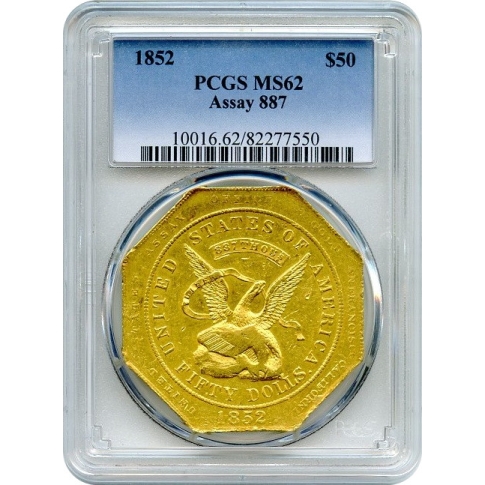1852 $50 California Gold Quintuple Eagle - U.S. Assay Office 887 PCGS MS62
This extremely rare variety has no recent auction records in comparable grades (last one was 14 years ago). The present specimen may well be the second finest known, at least by PCGS. PCGS Coin Facts reports only one other examples in grade of MS63, with only two MS62 or better examples of this variety reported. By PCGS, and none EVER selling at public acution, we need to look at data from the sale of other varieties in order to attempt to establish a more current value. For example, in January of 2014 Heritage sold Lot 5621, an 1851 $50 887 Thous. K-6, PCGS 62 for $440,625. IN September of 2017, there was an NGC MS62 example that realized $276,125 for the Humbert equivalent of this coin.
The current PCGS Price Guide lists MS62 at $200,000, with no relative data to support the number, however, the PCGS Price Guide for the 1852 $50 Humbert 887 Thous variety at $325,000 (with a similar, but higher, population).
New to the census, scarce, beautiful, historically significant, and in a high state of preservation, this impressive "slug" will certainly be the absolute centerpiece of a truly great Territorial Gold collection.
USA, TERRITORIAL CALIFORNIA GOLD, 1852 $50 United States Assay Office of Gold (USAOG) "887 THOUS." Target Reverse.
With strictly original pleasing light golden yellow surfaces and attractive orange highlights. The obverse shows more central detail than most of the examples we have had the privilege to examine, and the lustrous and very attractive reverse is remarkably free from any distracting contact marks. The most compelling of all of the territorial Gold Rush issues, these massive and impressive octagonal $50 gold pieces, affectionately known as "slugs," have a fascinating history which has made them the favorites of discriminating numismatists for generations.
On January 24, 1848 James W. Marshall discovered gold at Sutter's Mill in Coloma, California. Over 300,000 people migrated to California and many of them converged on San Francisco creating an economic boom of major proportions. This boom created an economic problem of major proportions, culminating in the minting of these legendary "Californians," "quintuple eagles," "five eagle pieces," or "slugs" - the $50 pieces produced by Augustus Humbert. United States Assayer of Gold in 1851 and 1852.
The economic problem arose from the simple fact that no United States mint existed in California. There was no way for miners, prospectors, or merchants to convert their gold into coins, and this made it extremely difficult to conduct simple business transactions. Petitions sprang up urging the state to set up a government assay office, but this suggestion was opposed by bankers, gold dust dealers and merchants who were making a good living buying or accepting gold in trade at a large discount.
The solution to the problem was the establishment of a United States Mint in San Francisco, but that required an act of Congress. Strong opposition came from the states that already had United States Mints - Pennsylvania, North Carolina, Louisiana and Georgia. A compromise was reached, and an act was passed in 1850 establishing a Federal Assay Office. The act authorized "ingots" of $50 to be struck, consisting of refined gold "... of uniform fineness ...." The legends were to include the words LIBERTY" and "UNITED STATES OF AMERICA." These "ingots" circulated like Federal gold coins, but their metallurgic composition differed from the gold coins that were issued by the official U. S. Mints. Copper, nitric acid, sulfuric acid and hydrochloric acids were necessary in order to create the proper metallic content, and these raw materials were not available on the West Coast.
Technically, the United States Assay Office was not a U. S. Mint, but the officials at the Philadelphia Mint treated Augustus Humbert as if he were a branch-mint supervisor. The production of the master dies and hubs for the "ingots" was carried out under the direct supervision of Mint officials. The "ingots" circulated side by side with U.S. and foreign gold coins of the period, and they were acceptable for the payment of all Customs duties.
| PCGS # | 10016 |
|---|---|
| Grading Service | NONE |
| Year of Issue | NONE |
| Grade | NONE |
| Denom Type | N/A |
| Numeric Denomination | $50 |
| Mint Location | NONE |
| Designation | NONE |
| Circ/UnCirc | Not Specified |
| Strike Type | N/A |
| Holder Variety | Assay 887 |
| Grade Add On | NONE |
| Holder Type | N/A |



